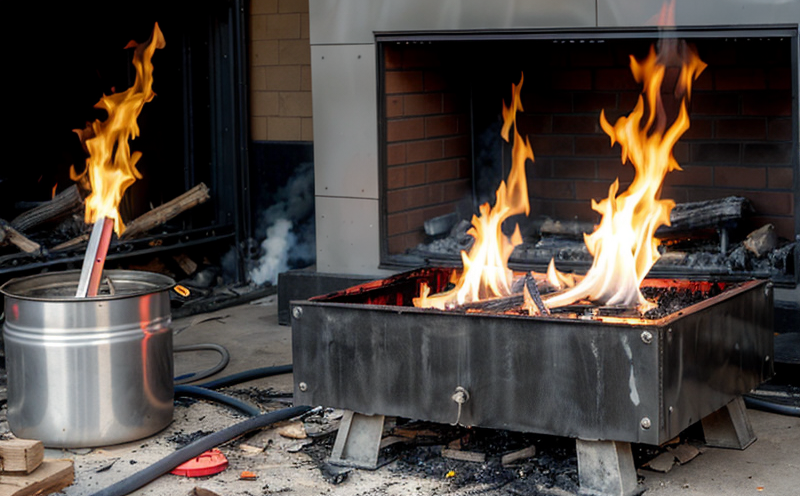Flammability Endurance Test for Consumer Electronics
The flammability endurance test is a critical quality assurance procedure designed to ensure that consumer electronics comply with fire safety regulations. This test evaluates how well the materials used in electronic devices can withstand exposure to flame without igniting or continuing to burn once the source of ignition has been removed. The objective is to prevent potential hazards and protect end-users from risks associated with overheating, short circuits, or other malfunctions that could lead to fires.
Consumer electronics encompass a wide range of products such as televisions, computers, mobile phones, and household appliances. Each of these devices contains various components made from different materials which may exhibit varying levels of flammability. The test simulates real-world conditions where the electronic device is exposed to flames for a specified duration under controlled laboratory settings.
The procedure involves placing specimens inside an oven or chamber equipped with gas burners that can produce flames at temperatures ranging between 500°C and 1200°C depending on the standard being followed. The temperature, duration of exposure, and method of introducing flame vary based on the type of material or product being tested but generally follow established protocols like those outlined in ASTM E648-21a.
Once exposed to fire for a predetermined time period, the specimen is removed from the chamber and observed for any signs of burning. The test continues until no further combustion occurs even after cooling down. Compliance with standards such as IEC 60335-2-47 ensures that manufacturers meet stringent safety requirements set forth by regulatory bodies worldwide.
Failure to pass this test indicates a higher risk of fire hazards, which can result in product recalls or legal actions against the manufacturer. Therefore, it is essential for quality assurance teams and compliance officers involved in developing new products or sourcing components from suppliers to understand these tests thoroughly so they can implement necessary changes early on in their design process.
Real-world applications highlight why flammability endurance testing remains crucial across industries. For instance, portable devices like laptops and tablets often use lithium-ion batteries which have been linked to several battery fires over the years. By conducting regular flammability tests during manufacturing processes, companies can identify potential issues early on before mass production begins.
Another example includes televisions with plastic casings that might melt under extreme heat generated by internal components failing due to overheating. Such failures could cause catastrophic incidents if not addressed promptly through rigorous testing procedures like those prescribed for flammability endurance tests.
- Product Safety: Ensures consumer protection against fire hazards caused by non-compliant electronic devices.
- Regulatory Compliance: Helps manufacturers adhere to local and international regulations governing electrical appliances and components.
- Risk Management: Identifies vulnerabilities in product design early enough for corrective actions to be taken.
In conclusion, the flammability endurance test plays a vital role in safeguarding consumer electronics against fire risks. Its importance cannot be overstated given its direct impact on public safety and brand reputation.
Applied Standards
The flammability endurance test for consumer electronics typically follows international standards such as ASTM E648-21a, IEC 60335-2-47, EN 60335-2-47, and UL94. These guidelines provide detailed instructions on specimen preparation, testing methods, and acceptance criteria to ensure consistent results across different laboratories.
ASTM E648 specifies the standard test method for flammability of plastics used in electrical and electronic equipment. It involves placing a small piece of plastic onto an open flame until it ignites spontaneously; then observing how long it continues burning after removal from the source. Compliance with this standard demonstrates that manufacturers have met rigorous testing requirements specific to their products.
IEC 60335-2-47 addresses the safety aspects related to household and similar appliances, including consumer electronics. This standard covers various tests aimed at ensuring fire resistance and preventing overheating incidents which could lead to fires. By adhering to these specifications, companies demonstrate their commitment to producing safe devices that comply with global standards.
EN 60335-2-47 is the European counterpart of IEC 60335-2-47 and includes additional requirements tailored specifically for use within EU member states. Similarly, UL94 sets stringent criteria for flammability performance in plastics commonly found in electronics manufacturing.
These standards not only guide manufacturers on proper testing procedures but also serve as benchmarks against which products can be evaluated. By meeting these international standards, companies can ensure their products are safe and reliable while complying with regulatory requirements imposed by various jurisdictions around the world.
Customer Impact and Satisfaction
The impact of successfully passing a flammability endurance test extends beyond mere compliance with regulations. It directly influences customer satisfaction by enhancing trust in the brand and product safety perception. When consumers know that their devices have undergone rigorous testing to ensure fire resistance, they are more likely to feel secure using them without worry.
Moreover, meeting these standards positively affects a company's reputation among stakeholders, including investors, partners, and employees. A strong track record of adhering to international norms not only promotes brand loyalty but also opens doors for future business opportunities.
International Acceptance and Recognition
The flammability endurance test enjoys widespread acceptance across numerous countries globally due to its proven effectiveness in identifying hazardous materials. Regulatory bodies in regions like North America (UL, CSA), Europe (CE marking under the Low Voltage Directive), Asia-Pacific (Australia/New Zealand SAA), and others recognize these tests as essential for consumer electronics safety.
International organizations such as the International Electrotechnical Commission (IEC) and the European Committee for Standardization (CEN) play key roles in developing and promulgating standards that govern this testing method. Their efforts ensure uniformity in approaches adopted by various nations towards ensuring electrical products are safe for use.
By participating in these international initiatives, manufacturers demonstrate their commitment to maintaining high-quality standards globally while fostering collaboration among experts from diverse backgrounds.





